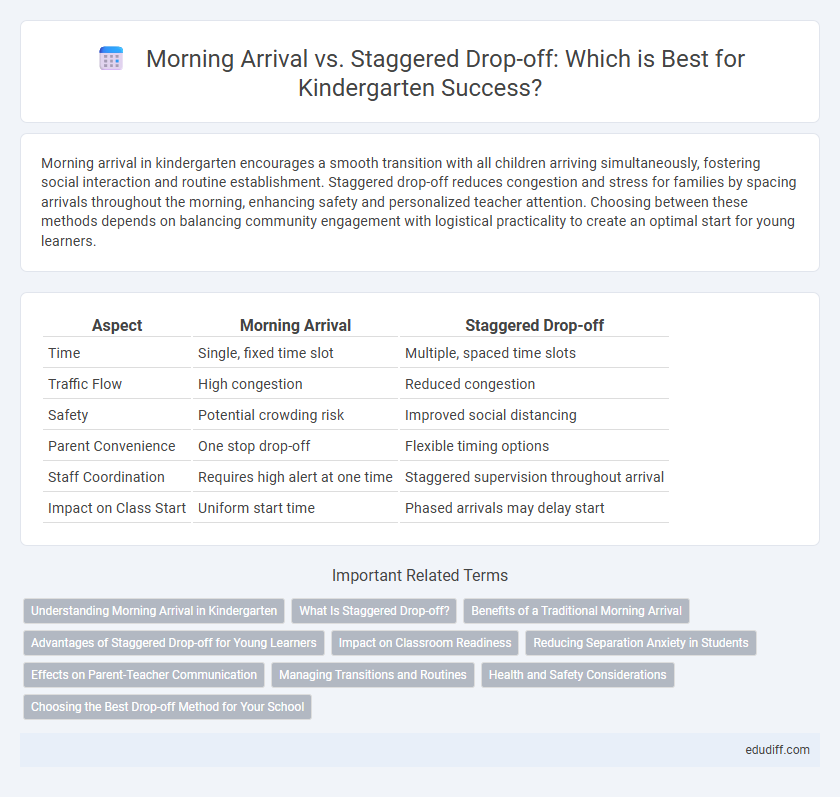Morning arrival in kindergarten encourages a smooth transition with all children arriving simultaneously, fostering social interaction and routine establishment. Staggered drop-off reduces congestion and stress for families by spacing arrivals throughout the morning, enhancing safety and personalized teacher attention. Choosing between these methods depends on balancing community engagement with logistical practicality to create an optimal start for young learners.
Table of Comparison
| Aspect | Morning Arrival | Staggered Drop-off |
|---|---|---|
| Time | Single, fixed time slot | Multiple, spaced time slots |
| Traffic Flow | High congestion | Reduced congestion |
| Safety | Potential crowding risk | Improved social distancing |
| Parent Convenience | One stop drop-off | Flexible timing options |
| Staff Coordination | Requires high alert at one time | Staggered supervision throughout arrival |
| Impact on Class Start | Uniform start time | Phased arrivals may delay start |
Understanding Morning Arrival in Kindergarten
Morning arrival in kindergarten involves a set time when all children arrive simultaneously, promoting a consistent routine that helps develop early time management skills. This approach encourages social interaction and classroom readiness as students engage in morning activities together, fostering a sense of community. Understanding the benefits of a unified arrival time highlights its role in creating a structured and welcoming environment for young learners.
What Is Staggered Drop-off?
Staggered drop-off is a scheduling approach where children arrive at kindergarten in small groups during designated time intervals rather than all at once. This method reduces congestion, enhances safety protocols, and allows teachers to engage with students more personally upon arrival. Implementing staggered drop-off can improve overall arrival efficiency and create a calmer start to the school day.
Benefits of a Traditional Morning Arrival
A traditional morning arrival in kindergarten fosters a cohesive start to the day by allowing all children to enter the classroom simultaneously, promoting social interaction and a sense of community. This approach enhances routine predictability, which supports young learners' emotional security and readiness for structured activities. Teachers can efficiently monitor and engage with all students at once, ensuring a smoother transition from home to school.
Advantages of Staggered Drop-off for Young Learners
Staggered drop-off improves young learners' transition into kindergarten by reducing congestion and minimizing separation anxiety through smaller, manageable groups. This approach allows educators to provide individualized attention during arrival, fostering a calm and supportive environment. Enhanced safety and smoother entry routines contribute to better daily engagement and readiness for learning.
Impact on Classroom Readiness
Morning arrival with all students coming at once often leads to crowded entryways and increased transition time, which can delay the start of instructional activities in kindergarten classrooms. Staggered drop-off reduces congestion, allowing teachers to engage with smaller groups of children and support smoother transitions that enhance classroom readiness. This approach promotes a calm environment conducive to early learning and social-emotional adjustment.
Reducing Separation Anxiety in Students
Implementing staggered drop-off times significantly reduces separation anxiety in kindergarten students by allowing a gradual and calm transition into the classroom environment. Morning arrival routines that incorporate individual greetings and personalized interactions create a sense of security, easing the emotional adjustment for young children. Structured arrival periods lower stress levels and promote a positive start to the day, fostering better social and academic engagement.
Effects on Parent-Teacher Communication
Morning arrival promotes more direct and spontaneous parent-teacher communication, allowing for immediate exchanges about children's needs and daily schedules. Staggered drop-off can limit these interactions by spacing out arrival times, potentially reducing opportunities for meaningful conversations. Consistent morning arrival routines foster stronger relationships and collaborative engagement between parents and educators in the kindergarten setting.
Managing Transitions and Routines
Morning arrival routines in kindergarten establish a consistent environment that helps children feel secure and ready to learn, minimizing disruptions and easing separation anxiety. Staggered drop-off reduces congestion and allows teachers to provide more personalized attention during the transition, fostering smoother handoffs and better emotional support. Effective management of these transitions supports the development of self-regulation skills and contributes to a positive, structured start to the school day.
Health and Safety Considerations
Morning arrival in kindergarten ensures a supervised and orderly start, reducing health risks through immediate temperature checks and hygiene protocols. Staggered drop-off minimizes crowding and close contact among children and parents, lowering the potential spread of illnesses. Both methods prioritize health and safety by managing exposure and maintaining consistent monitoring during arrival times.
Choosing the Best Drop-off Method for Your School
Morning arrival procedures impact student safety and traffic flow, making the choice between traditional drop-off and staggered drop-off crucial for kindergartens. Staggered drop-off reduces congestion by assigning specific arrival times, promoting a calm and organized environment that supports young children's transition into school. Evaluating your school's size, staff availability, and parent feedback ensures selecting the most efficient drop-off method that prioritizes safety and convenience.
Morning Arrival vs Staggered Drop-off Infographic

 edudiff.com
edudiff.com